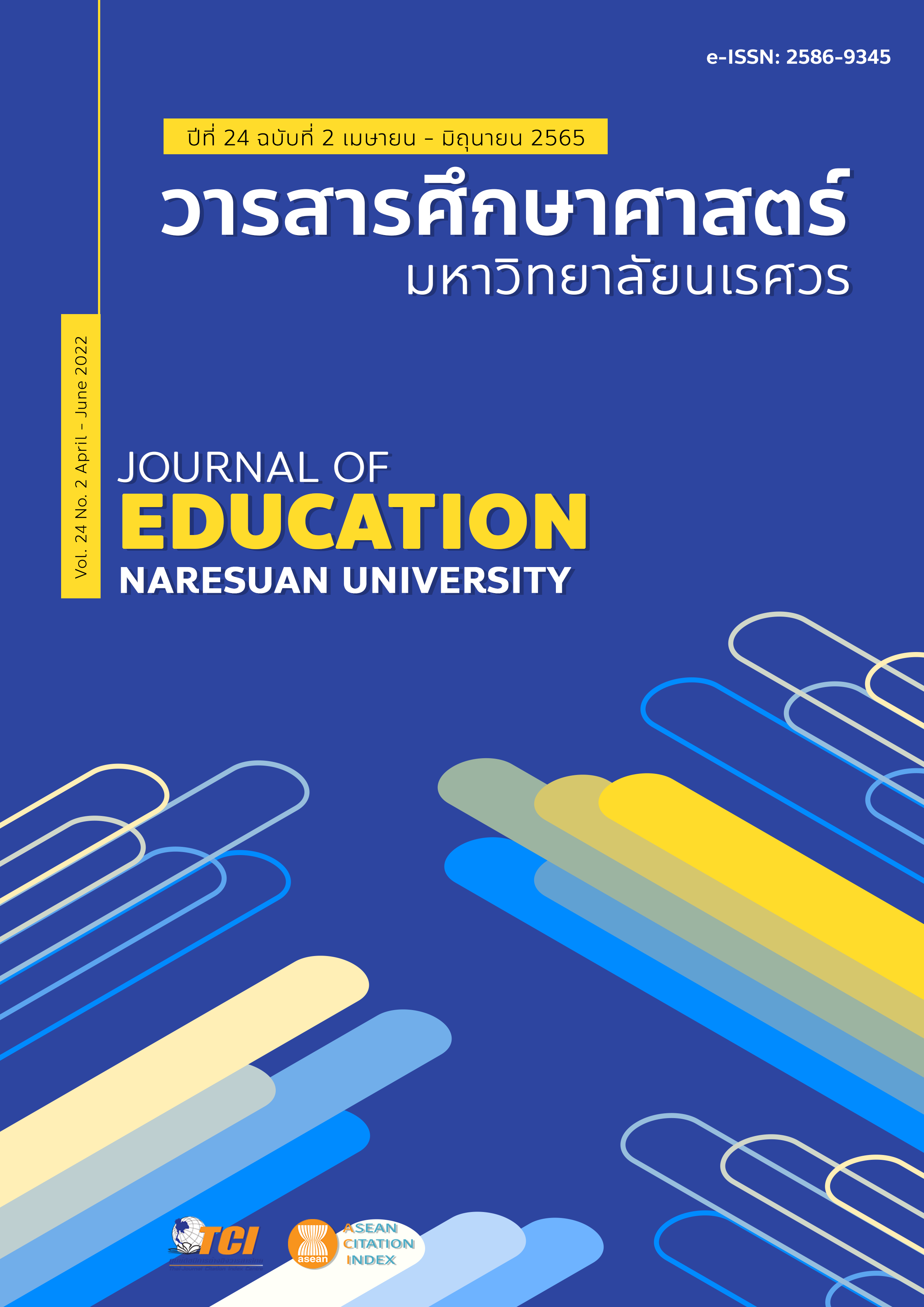การพัฒนาวิธีการประมาณค่าความเที่ยงของสัมประสิทธิ์แอลฟาแบ่งชั้นแบบใหม่ สำหรับมาตรวัดแบบพหุมิติ DEVELOPMENT OF ESTIMATION METHOD FOR THE RELIABILITY OF THE NEW STRATIFIED ALPHA COEFFICIENT FOR MULTIDIMENSIONAL SCALES
Main Article Content
บทคัดย่อ
การวิจัยนี้มีวัตถุประสงค์เพื่อ 1) พัฒนาวิธีการประมาณค่าความเที่ยงสัมประสิทธิ์แอลฟาแบ่งชั้นแบบใหม่ (ascr) 2) เปรียบเทียบประสิทธิภาพวิธี ascr กับวิธีการประมาณค่าความเที่ยงสัมประสิทธิ์แอลฟาแบบแบ่งชั้น (as) จำแนกตามความยาวแบบทดสอบและขนาดของกลุ่มตัวอย่าง จำนวน 54 สถานการณ์ และ 3) ประมาณค่าความเที่ยงของมาตรวัดแบบพหุมิติที่พัฒนาขึ้นด้วยวิธี เก็บรวบรวมข้อมูลจากผู้ที่มีอายุ 18-64 ปี จำนวน 2,368 คน ผลการวิจัยปรากฏว่า 1) ได้วิธีประมาณค่าความเที่ยงสัมประสิทธิ์แอลฟาแบ่งชั้นแบบใหม่ (ascr) 2) วิธี ascr มีประสิทธิภาพดีกว่าวิธี as กรณีกลุ่มตัวอย่างตั้งแต่ 50 คนและมีความยาวของข้อสอบ 60 ข้อขึ้นไป และกลุ่มตัวอย่างตั้งแต่ 400 คนและมีความยาวของข้อสอบ 10 ข้อขึ้นไป และ 3) ค่าความเที่ยงของมาตรวัดแบบพหุมิติ เท่ากับ .667, .762 และ .858 เมื่อความยาวของข้อคำถามในมาตรวัด เท่ากับ 18, 54 และ 84 ข้อ ตามลำดับ
Article Details

This work is licensed under a Creative Commons Attribution-NonCommercial-NoDerivatives 4.0 International License.
เจ้าของบทความมิได้คัดลอก หรือละเมิดลิขสิทธิ์ของผู้ใด หากเกิดการละเมิดลิขสิทธิ์ ไม่ว่าวิธีใด หรือการฟ้องร้องไม่ว่ากรณีใด ๆ ที่อาจเกิดขึ้นได้ กองบรรณาธิการวารสารศึกษาศาสตร์ ไม่มีส่วนเกี่ยวข้องทั้งสิ้น ให้เป็นสิทธิ์ของเจ้าของบทความที่จะดำเนินการ
References
Abbott, R. A., Ploubidis, G. B., Huppert, F. A., Kuh, D., Wadsworth, M. E., & Croudace, T. J. (2006). Psychometric evaluation and predictive validity of Ryff´s psychological wellbeing items in a UK cohort sample of women. Health and Quality of Life Outcomes, 4(76), 1-16. DOI: 10.1186/1477-7525-4-76
Banik, S., Kibria, B. M. G., & Sharma, D. (2012). Testing the population coefficient of variation. Journal of Modern Applied Statistical Methods, 11(2), 325-335. DOI: 10.22237/jmasm/1351742640
Cronbrach, L. J., Schönemann, P., & McKie, D. (1965). Alpha coefficients for stratified-parallel tests. Educational and Psychological Measurement, 25(2), 291-312.
Deng, L., & Chan, W. (2016). Testing the difference between reliability coefficients alpha and omega. Educational and Psychological Measurement, 77(2), 185-203. DOI: 10.1177/0013164416658325
Drolet, A. L., & Morrison, D. G. (2001). Do we really need multiple-item measures in service research? Journal of Service Research, 3(3), 196–204.
Drost, E. (2011). Validity and reliability in social science research. Education Research and Perspectives, 38(1), 105-123.
Hea, S.G., Wangb, G. A., & Cookb, D. F. (2011). Multivariate measurement system analysis in multisite testing: An online technique using principal component analysis. Expert Systems with Applications, 38(12), 14602-14608.
Henseler, J., Hubona, G., & Ray, P. A. (2016). Using PLS path modeling in new technology research: updated guidelines. Industrial Management & Data Systems, 116(1), 2-20.
Hinkle, D.E. (1998). Applied Statistics for the Behavioral Sciences. Boston: Houghton Mifflin.
Hunt, T. (2013). Covariance maximized lambda 4: An introduction of a low-biased reliability. Retrieved from University of Utah: https://mstat.utah.edu/degree-options/Covariance%20Maximized%20Lambda%204.pdf
Javali, S. B., Gudaganavar, N. V., & Raj, S. M. (2011). Effect of varying sample size in estimation of coefficients of internal consistency. Karnataka, India: Department of Biostatistics, SDM College of Dental Sciences.
Jöreskog, K. G., & Sörbom, D. (1999). LISREL 7: A guide to the program and application. Chicago: SPSS.
Kamata, A., Turhan, A., & Darandari, E. (2003). Estimating reliability for multidimensional composite score scale scores. Paper presented at the Annual Meeting of the American Educational Research Association, Chicago.
Kanjanawasee, S. (2013). Classical test theory (7th ed.). Bangkok: Chulalongkorn University Press. [in Thai]
Latif, L. A., Amadera, J. E. D., Pimentel, D., Pimentel, T., & Fregni, F. (2011). Sample size calculation in physical medicine and rehabilitation: A systematic review of reporting, characteristics, and results in randomized controlled trials. Archives of Physical Medicine and Rehabilitation, 92(2), 306-315. DOI: 10.1016/j.apmr.2010.10.003
Liu, J., Tang, W., Chen, G., & Lu, Y. (2016). Correlation and agreement: Overview and clarification of competing concepts and measures. Shanghai Archives of Psychiatry, 28(2), 115–120.
Louth, R. (2010). The next generation of optimization applications and theory. In Optimizing Optimization (pp. 247-281). New York: Elsevier.
Margono, G. (2015). Multidimensional reliability of instrument for measuring students' attitudes toward statistics by using semantic differential scale. American Journal of Educational Research, 3(1), 49-53.
Marwick, B., & Krishnamoorthy K. (2019). Tests for the equality of coefficients of variation from multiple groups. R software package version 0.1.3. Retrieved from https://github.com/benmarwick/cvequality
Mukkhuntod, W., & Lawthong, N. (2016). Effect of multidimensionality and reliability estimation methods on multidimensional reliability and effect of reliability estimation. Journal of Research Methodology, 29(3), 273-294. [in Thai]
Nisbet, R., Miner, G., & Yale, K. (2017). Handbook of statistical analysis and data mining applications (2nd ed.). New York: Elsevier.
Osburn, H. G. (2000). Coefficient alpha and related internal consistency reliability coefficients. Psychological Methods, 5(3), 343-335. DOI: IO.1037//1082-989X.5.3.343
Pascual-Ferrá, P., & Beatty, M. J. (2015). Correcting internal consistency estimates inflated by correlated item errors. Communication Research Reports, 32(4), 347-352. DOI: 10.1080/08824096.2015.1089858
Peters, G.-J. Y. (2014). The alpha and the omega of scale reliability and validity: Why and how to abandon Cronbrach’s alpha and the route towards more comprehensive assessment of scale quality. European Health Psychologist, 16(2), 55-69.
Raykov, T. (2001). Bias of coefficient alpha for fixed congeneric measures with correlated errors. Applied Psychological Measurement, 25(1), 69-76. DOI: 10.1177/01466216010251005
Raykov, T., & Grayson, D. (2003). A test for change of composite reliability in scale development. Multivariate Behavioral Research, 38(1),143-159.
Reed, G. F., Lynn, F., & Meade, B. D. (2002). Use of coefficient of variation in assessing variability of quantitative assays. Clinical and Diagnostic Laboratory Immunology, 9(6), 1235-1239. DOI: 10.1128/CDLI.9.6.1235-1239.2002
Ryff, C. D. (1989). Happiness is everything, or is it? Explorations on the meaning of psychological well-being. Journal of Personality and Social Psychology, 57(6), 1069-1081.
Ryff, C. D., & Keyes, C. L. M. (1995). The structure of psychological well-being revisited. Journal of Personality and Social Psychology, 69(4), 719-727.
Starkweather, J. (2012). Step out of the past: Stop using coefficient alpha; There are better ways to calculate reliability. Retrieved from http://web3.unt.edu/benchmarks/issues/2012/06/rss-matters
Widhiarso, W. (2007). Estimating Reliability for Multidimensional Measure. Yogykarta, Indonesia: Faculty of Psychology, Gadjah Mada University.
Widhiarso, W., & Ravand, H. (2014). Estimating reliability coefficient for multidimensional measures: A pedagogical illustration. Review of Psychology, 21(2), 111-121.
Wong, G., Maraun, D., Vrac, M., Widmann, M., Eden, J. M., & Kent, T. (2014). Stochastic model output statistics for bias correcting and downscaling precipitation including extremes. Journal of Climate, 27(18), 6940-6959.

